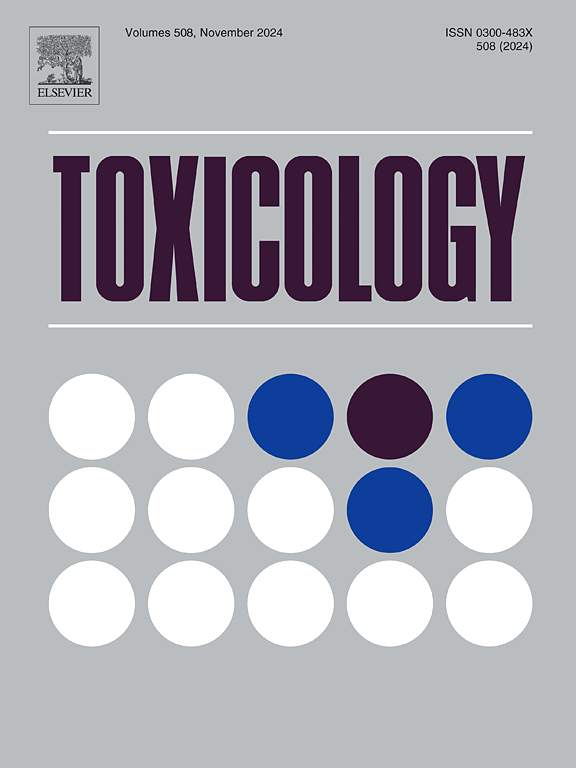三种典型的有机磷阻燃剂通过诱导Nthy-ori 31 - 1细胞的氧化应激或炎症反应触发甲状腺激素合成。
IF 4.6
3区 医学
Q1 PHARMACOLOGY & PHARMACY
引用次数: 0
摘要
越来越多的证据表明,有机磷阻燃剂(OPFRs)会干扰动物的甲状腺功能。然而,关于OPFR暴露对人甲状腺激素(TH)合成影响的研究仍然有限且存在争议。在这项研究中,我们试图研究三种典型的OPFRs,包括三(2-氯乙基)磷酸(TCEP),三(2-丁氧乙基)磷酸(TBEP)和三苯基磷酸(TPHP)对人甲状腺滤泡上皮Nthy-ori 3-1细胞TH合成的影响及其机制。结果表明,对Nthy-ori 3-1细胞的细胞毒性倾向为TPHP > TBEP > TCEP。此外,与TCEP和TBEP相比,低浓度TPHP显著提高了甲状腺素水平和甲状腺相关功能蛋白mRNA表达,包括甲状腺过氧化物酶、促甲状腺素受体和甲状腺球蛋白。进一步分析表明,TBEP和TCEP引起线粒体功能障碍和氧化磷酸化损伤,从而升高氧化应激,这可以通过活性氧和脂质过氧化的增加来证明。相反,TPHP通过激活TNF/IL-17/MAPK信号通路介导炎症反应,从而触发TH合成。综上所述,本研究揭示了三种OPFRs通过诱导氧化应激或炎症反应不同程度地触发TH合成,为OPFRs对人甲状腺的作用机制提供了新的认识。本文章由计算机程序翻译,如有差异,请以英文原文为准。
Three typical organophosphorus flame retardants trigger thyroid hormone synthesis by inducing oxidative stress or inflammation reactions in Nthy-ori 3‑1 cells
Accumulating evidence shows that organophosphorus flame retardants (OPFRs) can interfere with thyroid function in animals. However, studies on the effect of OPFR exposure on human thyroid hormone (TH) synthesis remain limited and controversial. In this study, we sought to investigate the effects and mechanisms of three typical OPFRs, including Tris (2-chloroethyl) phosphate (TCEP), tris (2-butoxyethyl) phosphate (TBEP), and triphenyl phosphate (TPHP), on TH synthesis using human thyroid follicular epithelial Nthy-ori 3–1 cells. The results showed that the cytotoxicity trend toward Nthy-ori 3–1 cells was TPHP > TBEP > TCEP. Moreover, TPHP significantly increased thyroxine levels and mRNA expression of thyroid-related functional proteins including thyroid peroxidase, thyrotropin receptor, and thyroglobulin at lower concentrations compared with TCEP and TBEP. Further analysis indicated that TBEP and TCEP caused mitochondrial dysfunction and impairment of oxidative phosphorylation, thereby elevating oxidative stress, as demonstrated by increases in reactive oxygen species and lipid peroxidation. In contrast, TPHP triggered TH synthesis by mediating inflammation reactions via activation of the TNF/IL-17/MAPK signaling pathway. In conclusion, this study revealed that the three OPFRs triggered TH synthesis to varying degrees by inducing oxidative stress or inflammation reactions, providing new insights into the mechanisms of action of OPFRs on the human thyroid.
求助全文
通过发布文献求助,成功后即可免费获取论文全文。
去求助
来源期刊

Toxicology
医学-毒理学
CiteScore
7.80
自引率
4.40%
发文量
222
审稿时长
23 days
期刊介绍:
Toxicology is an international, peer-reviewed journal that publishes only the highest quality original scientific research and critical reviews describing hypothesis-based investigations into mechanisms of toxicity associated with exposures to xenobiotic chemicals, particularly as it relates to human health. In this respect "mechanisms" is defined on both the macro (e.g. physiological, biological, kinetic, species, sex, etc.) and molecular (genomic, transcriptomic, metabolic, etc.) scale. Emphasis is placed on findings that identify novel hazards and that can be extrapolated to exposures and mechanisms that are relevant to estimating human risk. Toxicology also publishes brief communications, personal commentaries and opinion articles, as well as concise expert reviews on contemporary topics. All research and review articles published in Toxicology are subject to rigorous peer review. Authors are asked to contact the Editor-in-Chief prior to submitting review articles or commentaries for consideration for publication in Toxicology.
 求助内容:
求助内容: 应助结果提醒方式:
应助结果提醒方式:


